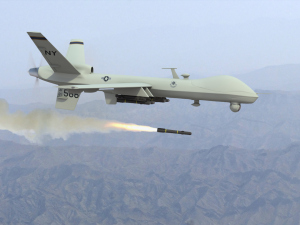|
By Coleen Rowley and Robin Hensel
From Global Research | Original Article
Why has the United Nations Special Rapporteur called drone strikes extrajudicial killing?

Why has a Pakistani judge recently filed criminal charges against a former top CIA lawyer who oversaw its drone program and a former station chief in Islamabad over a 2009 strike that killed two people? The Islamabad High Court ruled CIA officials must face charges including murder, conspiracy, waging war against Pakistan and terrorism.
Why is a case being heard in May against the German government on behalf of three Yemeni survivors of a U.S. drone strike? The lawsuit argues it is illegal for the German government to allow the U.S. air base at Ramstein to be used for drone murders abroad, especially after the passage of a resolution in the European Parliament in February 2014 urging European nations to “oppose and ban the practice of extrajudicial targeted killings” and to “ensure that Member States, in conformity with their legal obligations, do not perpetrate unlawful targeted killings or facilitate such killings by other states.”
Why have Sicilians been protesting construction – which in 2013 led to the President of the Region of Sicily temporarily revoking construction authorization – of a US Navy base in their desert which would house Lockheed Martin’s new satellite communications system? Part of the effort to automate war, to entrust the choice of targets to machines, a principal function of the system would be to remotely pilot drones all over the world, ultimately reaching the North Pole.
Closer to home, why have protests arisen of Camp Ripley’s drone training? When Col. St. Sauver, the commander at Camp Ripley, weighed in on the beginning controversy in September 2012, he lauded unmanned aircraft systems (UAS) as being used “to increase efficiency, save money, enhance safety and even save lives.” He hit all the Pentagon talking points. The smaller “Shadow” drones at Camp Ripley were initially used to conduct surveillance and identify people (targets) for the lethal punch of the larger “Reaper” and “Predators.” The smaller drones then served merely as an accomplice in the illegal drone assassination program, also termed President Obama’s “Disposition Matrix” kill list.
The goal of the U.S. State Department was, however, to arm the Shadows with guided bombs weighing under 25 pounds. Cleared for treaty compliance in 2011, Raytheon successfully tested a new 5 pound warhead developed for the Shadow that same year and in 2012, tested a 13 pound warhead. The Marine Corps thereafter sent armed Shadows to Afghanistan as a combat demonstration program.
As a result of this high tech trend, some military officials have become even more effusive in their praise of
“federated airpower as small UAVs (like the Shadow) can be bought and operated in numbers that provide far wider battlefield coverage. … When smart networks communicate, almost brain-like systems will emerge.”
Down on earth, however, the short answer to all the questions posed above is that the law may be catching up with the stars in militarists’ eyes. While commentators generally agree UAS technology is not illegal per se (which people often confuse the drone debate as being), when and how it’s being used to extra-judicially kill in our self-declared “global war” is another story.
The following constitutes a consensus of legal opinion:
Outside a war zone, a State can legally kill only where (1) necessary to save a life, and no other option is available, or alternatively (2) it’s the result of fair judicial process [e.g., death penalty after decent adjudication].
So drones – at least those used for targeting killing – are basically not legal unless the looser “law of armed conflicts” (aka international humanitarian law, IHL) applies. IHL only governs in unique, geographically constrained and limited situations, not in a “war of choice” or a “global war.” Even under IHL, you can’t kill civilians (those not operating as forces of a warring State) unless they’re directly participating in hostilities, or in a “continuous combat function.” This may explain why the U.S. has thus far refused to provide information about its strikes. Lastly, under IHL, even if you have a valid target, you still can’t kill that target if the civilian casualties would be disproportionate to the particular objective.
A final problem with how we use our drones is more a problem of angering other nations, increasing enemies and setting bad precedent. Obviously, a foreign country does not have the right to come into the United States and kill people. The guiding document is the U.N. Charter, which doesn’t allow force against a State unless it’s self-defense, or the Security Council authorizes it. So consider if a country, take China for example, decided to someday post drones over U.S. cities and execute people when it determined that people here were fighting against it, knowing civilian casualties are to be accepted, as long as China doesn’t consider our casualties disproportionate to its military objectives.
You don’t have to be a legal expert to understand the terrifying precedent the U.S. is setting.
Robin Hensel is a free speech and peace activist in Little Falls who organizes the annual “Peace Fair” and anti-drone warfare protests there.
Coleen Rowley is a retired FBI agent and former chief division counsel in Minneapolis. She’s now a dedicated peace and justice activist and board member of the Women Against Military Madness and works with the Veterans for Peace chapter in Minneapolis, Minnesota.
|